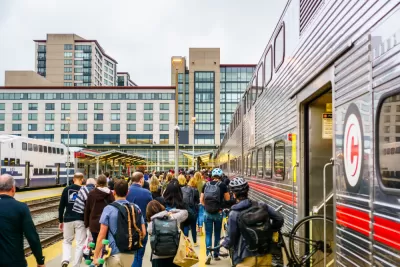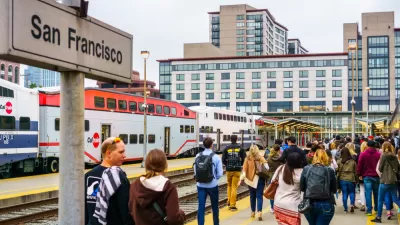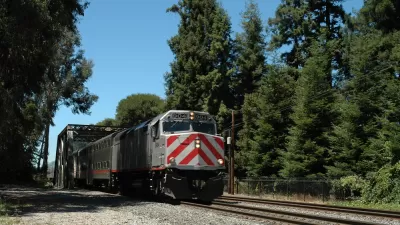The agency wants to increase service and extend its infrastructure to move Caltrain from a commuter rail system to an integrated urban transit network.

Erin Baldassari reports on new expansion plans for Caltrain in the San Francisco Bay Area as the region anticipates significant population growth in the future and the need for a more extensive transit network. "Caltrain’s vision contemplates BART-like 'show-up and go' service, whisking passengers from San Francisco to Gilroy on trains that run at least every 15 minutes all day long."
Caltrain expects that increasing service frequently and capacity would boost ridership from 65,000 daily riders to 180,000. This would give commuters more travel options and decrease traffic congestion and pollution in the region, say advocates. The agency is also looking at a slew of capital projects, along with the addition of electric trains, which operate faster than diesel trains.
But, says Baldassari, the price tag for these upgrades is high, including $90 million a year in operating subsidies. Possible funding sources include a multicounty sales tax increase and a regional transportation funding measure.
"The region is only going to continue to grow, said Adina Levin, the co-founder of Friends of Caltrain, a transit advocacy organization. So why not aim high, she said, even if the vision isn’t ultimately achieved due to factors outside of Caltrain’s control, such as the fate of high-speed rail."
FULL STORY: Caltrain has an ambitious plan to run BART-like service. Here’s what it will mean for Bay Area traffic

Planetizen Federal Action Tracker
A weekly monitor of how Trump’s orders and actions are impacting planners and planning in America.

Restaurant Patios Were a Pandemic Win — Why Were They so Hard to Keep?
Social distancing requirements and changes in travel patterns prompted cities to pilot new uses for street and sidewalk space. Then it got complicated.

Map: Where Senate Republicans Want to Sell Your Public Lands
For public land advocates, the Senate Republicans’ proposal to sell millions of acres of public land in the West is “the biggest fight of their careers.”

Maui's Vacation Rental Debate Turns Ugly
Verbal attacks, misinformation campaigns and fistfights plague a high-stakes debate to convert thousands of vacation rentals into long-term housing.

San Francisco Suspends Traffic Calming Amidst Record Deaths
Citing “a challenging fiscal landscape,” the city will cease the program on the heels of 42 traffic deaths, including 24 pedestrians.

California Homeless Arrests, Citations Spike After Ruling
An investigation reveals that anti-homeless actions increased up to 500% after Grants Pass v. Johnson — even in cities claiming no policy change.
Urban Design for Planners 1: Software Tools
This six-course series explores essential urban design concepts using open source software and equips planners with the tools they need to participate fully in the urban design process.
Planning for Universal Design
Learn the tools for implementing Universal Design in planning regulations.
Heyer Gruel & Associates PA
JM Goldson LLC
Custer County Colorado
City of Camden Redevelopment Agency
City of Astoria
Transportation Research & Education Center (TREC) at Portland State University
Camden Redevelopment Agency
City of Claremont
Municipality of Princeton (NJ)





























